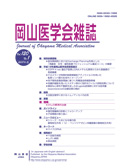

Journal of Okayama Medical Association
Published by Okayama Medical Association<Availability>
Full-text articles are available 3 years after publication.
Permalink : http://escholarship.lib.okayama-u.ac.jp/17455
Studies on urinary bilirubin Part 2. Clinical significance of urinary bilirubin phosphate fraction in various liver disease
Yamamoto, Takehiko
Published Date
1975-08-31
Abstract
In order to study the clinical significance of urinary bilirubin phosphate fraction, eight cases with acute hepatitis, seven cases with chronic hepatitis, five cases with liver cirrhosis, eight cases with obstructive jaundice and three cases with acute yellow liver atrophy were studied. The comparative study of the percentage of bilirubin phosphate fraction to the ester-form bilirubin and various liver function tests was investigated. Crude direct bilirubin was extracted from the jaundiced urine in the cases of liver diseases and fractionated into ester-form bilirubin by Kosaka-Hara's method and fractionated into three bilirubin fractions by the cellulose powder column chromatography with the solvent system of n- butanol, ethanol and water (4:1:2). The third fraction showed positive phosphate-ester reaction (bilirubin phosphate), and the glucuronic acid was negative in this fraction. 1. Percentages of bilirubin phosphate fraction to total ester-form bilirubin were 26.7 in the acute yellow liver atrophy, 11.27 in liver cirrhosis, 9.24 in the obstructive jaundice, 6.83 in the chronic hepatitis, and 6.09 in the acute hepatitis in each average, respectively. 2. Significant correlation could be found between the percentage of bilirubin phosphate fraction to the ester-form bilirubin and various liver function tests, that is, thymol turbidity test, zinc sulfate turbidity test and the percentage value of serum γ-globulin. 3. The decreasing tendency of the percentage of bilirubin phosphate fraction to the esterform bilirubin could be indicated the improvement of the liver function tests and the course of the disease.
ISSN
0030-1558
NCID
AN00032489
